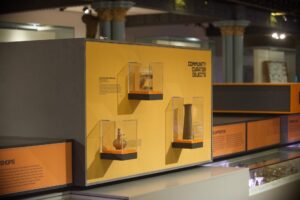Knowledge Exchange: Black History Month 2022

In this Knowledge Exchange we hear from Nelson Cummins, Communities and Campaigns Officer at Coalition for Equality and Rights (CRER). Nelson talks about the work CRER do across Scotland to eliminate racial discrimination and harassment and promote racial justice. We also learn about the significance of Black History Month in Scotland and how museums, galleries, and heritage organisations can participate in the programme.
View the Black History Month Scotland programme for 2022. Please contact Nelson Cummins at nelson@crer.org.uk for any queries about getting involved in the Black History Month Scotland programme.
Q & A
What is missing from the programme/what do people want to see in there from museums and galleries?
A: People connect with events on histories that feel local to them. Glasgow is a great place for that. But I think they really like that local perspective.
It’s tricky to say one type of event in particular, because I know there’s always lots of different ideas. I think one thing that seems to have worked quite well is people being able to see a side of something in the museum that they’ve not seen before. That can obviously take on lots of different forms, whether it’s something in the collection or whether it’s a tour of the building, offering more information about it than they’ve had the opportunity to access before. There’s lots of different things that could be within that, but I’d say they’re the sort of two main things that I think quite often stand out to people.
How can museums without collections be involved in BHM?
A: It doesn’t just have to be collection focused, museums can work with local community groups or schools and ask them if there’s something they want to put on using the museum space.
You mentioned in your presentation that Black History Month is only one month of the year or maybe six weeks of the year, and then it’s done. Should this not be something we do every day? How do we make sure this isn’t only talked about one month out of the year?
A: That’s 100% the aim. I think it can be based on the engagement with black history month that we have in Scotland. Black History Month can represent a starting point for organisations to become more involved with this work. I think the attention that we get around the month is great and it’s how we use that. This is about using the assets we have locally and using an asset based approach to push that forward, local people becomes assets too. We should use the events, programmes and partnership working established during BHM as building blocks for continuing these conversations about inclusion and representation.
What’s going to make community groups want to participate and join in with events or programmes we (museums) organise? How will we ensure they’re getting something out of it?
A: On this point about engagement, there can be a lot of fear about doing it wrong. I think one of the main things is really having those conversations and being open and having people come in and sit down and explain, you know, we’re looking at this, is this something you’re interested in? Would you be interested in making sure that the conversation is an equal conversation? So it doesn’t mean you have to have the right answer, but if you’re speaking to them, and you’re giving them the chance to also input directly into what it is and how they see this potential partnership working, then you’re less likely to get it wrong. Bring them in right in the beginning, have that conversation and understand and be honest about budgets and expectations so that you’re not giving them a false idea of what you can do. Be clear on what it is and the parameters you have. If the partnership working is a success and provides a benefit to the community group then you can also work together in the future.